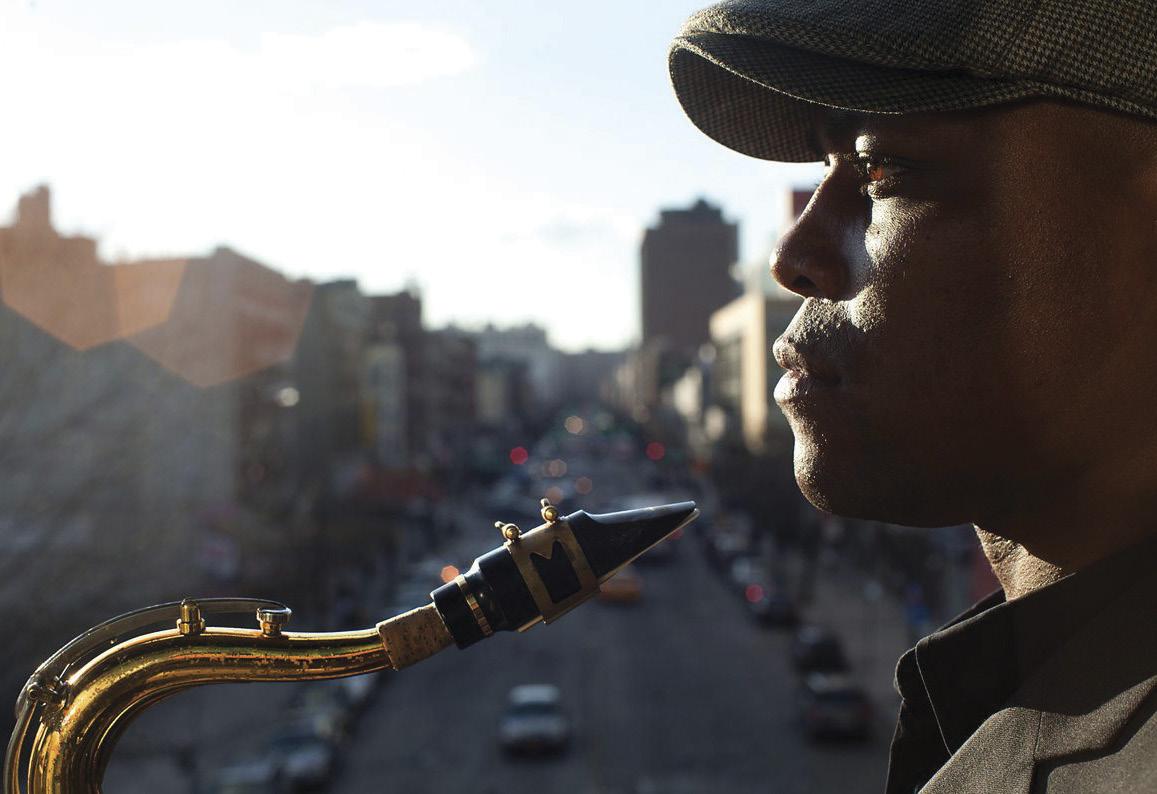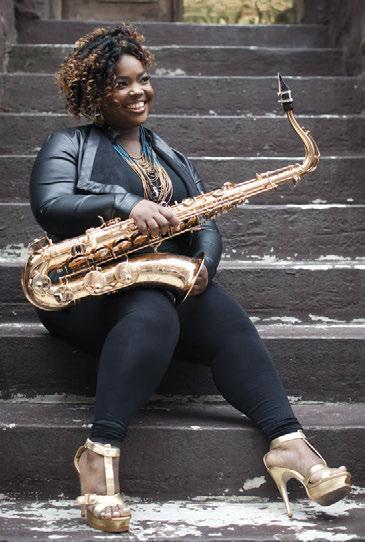
5 minute read
This year’s Hudson Jazz Festival honors the music of Alice and John Coltrane
In the Tranes’ Name
THE 2020 HUDSON JAZZ FESTIVAL
Advertisement
November 13–December 20 Hudsonhall.org.

There’s music that’s stylistically transcendental, that cuts across genre boundaries and appeals to all kinds of listeners. And there’s also music that’s itself transcendental, that puts forth a profound, mystical feeling, inspiring listeners to look both skyward and inward as they contemplate their place in the universe. Very rarely has there been music that does both of these things. But the music Alice and John Coltrane made, individually and together, certainly does. It attracts not only jazz fans, but also those denizens of the classical, R&B, psychedelic, hip-hop, experimental, and world-music realms who are open to searching, soulful sounds. It was the shared sonic quality and farreaching allure of the Coltranes’ music that Cat Henry, the curator of the 2020 Hudson Jazz Festival, had in mind while she was assembling the event, which will run from November 13 through December 20 virtually and at Hudson Hall.
“Their music has a real healing aspect to it,” Henry says. “Like [John Coltrane’s 1963 album] A Love Supreme, which deals with grieving and recovery. That’s something that’s we really need right now. With the

festival, I didn’t want it to just be a tribute series. Even though the festival programming does reflect on John and Alice’s legacy, it also connects with that healing force of their music and how it relates to people living through difficult times. And to the struggle for racial justice that was going on when they were alive and is still going on now.”
The six-week festival, designed to pick up Hudson’s cultural-economic baton from the summer Shared Streets mercantile program enacted by the city in response to COVID-19, will bring some of the contemporary jazz scene’s standout musicians to Hudson Hall for live-streamed concerts. It all begins on November 13 with the opening of “Art & Soul,” a festival-long group art show managed by local artist Reginald Morrison and featuring living room-like, health protocol-mindful “pods” in which attendees can relax and listen to handpicked playlists. The run of live-streamed performances kicks off with harpist Brandee Young and her trio (November 14), followed by the Marcus Strickland Quartet (November 21), the Orrin Evans Trio (November 28), the JD Allen Trio (December 4),


Clockwise from top: Marcus Strickland, Orrin Evans, Camille Thurman, Brandee Younger, JD Allen and the Camille Thurman with the Darrell Green Trio (December 12). Also planned are free talks by Grammy winner Ashley Kahn, the author of the John Coltrane biography A Love Supreme, the Impulse! Records history The House That Trane Built, and other books; noted musicologist Kwame Coleman; and others.
“The Coltranes were deeply spiritual people, and their lives were a shared expression of their music,” offers Henry, who served as vice president of Jazz at Lincoln Center’s concerts and touring wing from 2014 to 2020. “They were about peace, togetherness, and harmony, which is what we want to bring to Hudson with this festival.”
The Hudson Jazz Festival will take place from November 13 through December 20 at Hudson Hall in Hudson. Livestreamed concerts will air November 13 through December 12 at 7pm (tickets are $20 or pay what you can for each concert; a package pass for all five concerts is $75). The “Art & Soul” exhibit is free on Fridays through Sundays from 1 to 5pm, with timedentry admittance (online reservations are required). —Peter Aaron

Jean-Marc Superville-Sovak has a passion for history, especially those corners of history that don’t make it into textbooks. “New York State was the number one destination on the Underground Railroad,” he informs me. “John Brown [the radical abolitionist] is buried in the Adirondacks.” Superville-Sovak is also an artist, who has combined his love of history and art to curate “We Wear the Mask: Race and Representation in the Dorsky Museum Permanent Collection.” The show will be on view until November 22.
“We Wear the Mask” is an ambitious survey, including an Ethiopian Christian gouache, a portrait of a child by the Harlem photographer James Van Der Zee (1925), an ancient Egyptian pottery figurine of a slave, and two pieces by Richard Howard Hunt, the first African-American sculptor to have a retrospective at the Museum of Modern Art, in 1969. Two Polaroid portraits of the artist JeanMichel Basquiat by Andy Warhol are included. The photographer who took these pictures was not the aloof, blasé Warhol persona everyone knows. He was a careful, sensual observer, especially attuned to the private pain of celebrities.
You can see Andy Warhol’s envy in these photos, as he stares at the inspired artist with luscious, creamy skin who is electrifying the art world, while Warhol’s greatest work was behind him. But in Basquiat’s face we see the torments of a young man who too swiftly became famous for his bitter paintings mocking racism. One of the Basquiat portraits is paired with a famous Goya etching, The Dream of Reason Produces Monsters, showing a man asleep at his desk, as bats and owls flock around him. Basquiat was also beset by a host of demons. He died of a drug overdose in 1988.
The stereoscope was a 19th-century gadget allowing one to see three-dimensional images by placing a card with two identical photographs in a wire holder. The paired photographs were usually black-and-white, like the one in this show, of AfricanAmerican sharecroppers picking cotton, as their overseer lurks behind on horseback (Cotton is King Plantation Scene, Georgia, circa 1900). Tourists would watch cotton pickers the same way they might gaze at a marina full of colorful sailboats—without considering the near servitude and penury of the workers before them. “To me, there is something obscene about this image,” Superville-Sovak writes in the wall text.
This is the first show the artist has curated, but he is not entirely new to the process of selection. “Every good artist has to curate their own work,” he points out. The exhibition doesn’t feel didactic, but rather like a gathering of neglected jewels and surprises.
Only a small percentage of the 6,000 items in the Dorsky collection is typically on view. It’s gratifying to see pieces that usually remain in storage. Often, African-American art objects find themselves on those sad shelves.
The Black Lives Matter movement challenges us to examine the racism within us. It’s a long, grueling, and liberating effort. “We Wear the Mask” is a visual companion to that struggle. —Sparrow Aaron Siskind, Church Interior, Harlem, 1938
Masks That Don’t Come off
“WE WEAR THE MASK” AT THE DORSKY MUSEUM
Through November 22 Newpaltz.edu/museum










